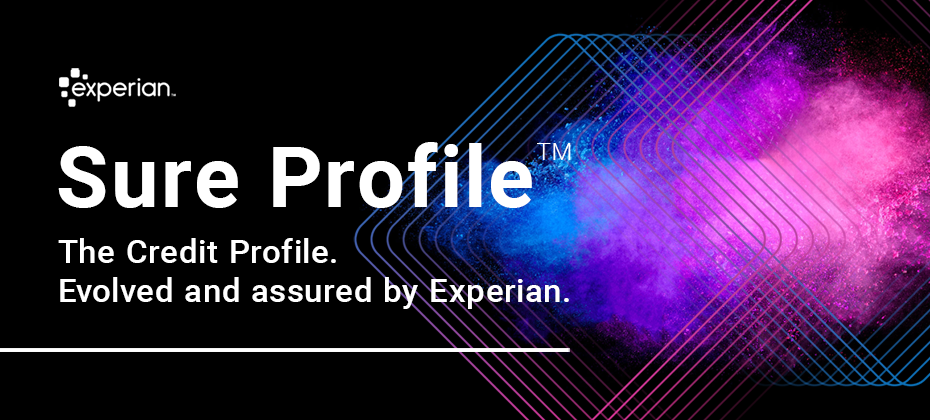Tag: identity protection

To combat the growing threat of synthetic identity fraud, Experian recently announced the launch of Sure ProfileTM, a revolutionary change to the credit profile that gives lenders peace of mind with Experian’s commitment to share in losses that result from an identity we’ve assured. “Experian has always been a leader in combatting fraud, and with Sure Profile, we’re proud to deliver an industry-first fraud offering integrated into the credit profile that mitigates lender losses while protecting millions of consumers’ identities,” said Robert Boxberger, President of Decision Analytics, Experian North America. Synthetic identity fraud is expected to drive $48 billion in annual online payment fraud losses by 2023. Between opportunistic fraudsters and a lack of a unified definition for synthetic identity theft it can be nearly impossible to detect—and therefore prevent—this type of fraud. This breakthrough solution provides a composite history of a consumer’s identification, public record, and credit information and determines the risk of synthetic fraud associated with that consumer. It’s not just a fraud tool, it’s a comprehensive credit profile that utilizes premium data so lenders can make positive credit decisions. Sure Profile leverages the capabilities of the Experian Ascend Identity PlatformTM and uses Experian’s industry-leading data assets and data quality to drive advanced analytics that set a higher level of protection for lenders. It’s powered by newly-developed machine learning and AI models. And it offers a streamlined approach to define and detect synthetic identities early in the originations process. Most importantly, Sure Profile differentiates between real people and potentially risky applicants so lenders can increase application approvals with greater assurance and less risk. “Experian can confidently define and help detect synthetic fraud. That's why we can help stop it,” said Craig Boundy, CEO of Experian North America. “Experian stands behind our data with assurance given to our clients. It’s better for lenders and it’s better for consumers.” Sure Profile is a complement to our robust set of identity protection and fraud management capabilities, which are designed to address fraud and identity challenges including account openings, account takeovers, e-commerce fraud and more. This first-of-its kind profile is the future of underwriting and portfolio protection and it’s here now. Read press release Learn More About Sure Profile

Experian has been named one of the 10 participants, and only credit bureau, in the initial rollout of the SSA's new eCBSV service.

Businesses may be increasingly aware of identity theft threats to their customers, but an Experian survey shows that many consumers still seriously underestimate their risk of falling victim to identity thieves. In fact, the persistent and harmful myth that the majority of consumers are not vulnerable to identity theft is badly in need of debunking. Consumer misconceptions The online Experian survey of 1,000 Americans, age 18 and older, found many consumers have a false sense of security about identity theft, even those who regularly engage in behaviors that can dramatically elevate their risk of having their identities stolen. For example: Sixty-two percent of consumers said the security of their personal information online is a minor concern that doesn’t worry them much, and 17 percent never worry about it at all. The top reason for their lack of concern? Twenty-seven percent said it was because they didn’t share that much personal identifiable information (PII) online. Yet consumers store an average of 3.4 types of PII online, and have a large digital footprint that can make it easy for cybercrooks to track and steal their information. Half believe poor credit means identity thieves won’t be interested in stealing their PII. Twelve percent believe they’re safe because they take security precautions, and 9 percent think using only secure websites insulates them from identity theft risks. Risky behaviors When identity theft occurs, consumers are likely to blame any business they associate with the theft. A Gemalto survey found that consumers said protecting their data is 70 percent the responsibility of the companies they do business with, and just 30 percent their own responsibility, Infosecurity Magazine reports. What’s more, 29 percent said they don’t think businesses take their responsibilities seriously enough when it comes to protecting consumer data. Yet the survey found consumers are probably far more responsible for identity theft than they think because they continue to engage in behaviors that put them at greater risk. These include: Shopping online over a public Wi-Fi connection (43 percent) Allowing others to use online account names and passwords (33 percent) Letting others know their mobile device passwords (29 percent) Sharing payment card numbers and/or PINs (25 percent) Letting others use their PII to secure a job or credit (20 percent) Failing to enroll in credit monitoring or identity theft protection services (82 percent) Leaving it up to their banks and credit card companies to catch signs of fraud (81 percent) These dangerous habits can expose consumers’ PII to cybercriminals, even though half of those we surveyed didn’t think they were likely to become victims of identity theft. Impact of identity theft When consumers become identity theft victims, they experience a range of negative emotions and real consequences that affect them personally and financially. According to a survey by the Identity Theft Resource Center, identity theft victims reported feeling frustrated, fearful, angry and stressed. Many had trouble concentrating, lost sleep and felt physically ill because of the crime. They also reported the identity theft overshadowed their personal relationships, their personal and professional credibility, and even affected their ability to get jobs. Some even lost their jobs as a result. What companies can do Clearly, identity theft can be devastating and consumers need to do more to protect themselves. When it occurs, identity theft also undermines the consumer’s trust in companies and institutions, especially if the identity theft occurred in connection to or following a data breach. Helping consumers protect themselves from identity theft benefits everyone. Consumers can avoid the financial and emotional turmoil identity theft causes, and companies can help preserve their relationship with customers. As part of an effective data breach response plan, companies should include a consumer care element that provides breached consumers with: Free identity theft protection and credit monitoring services Dark web and internet records scanning Fraud resolution services Identity theft insurance Myth debunked Year after year, identity theft statistics demonstrate that most consumers are at risk of falling prey to identity thieves, no matter what they believe to the contrary. Unfortunately, consumers continue to take actions that can place their identities at risk. While you can’t force your customers to stop accessing their bank accounts over airport Wi-Fi or using the same password for all their financial accounts, you can take steps to reduce the risk they’ll experience identity theft because of something your organization did or didn’t do. Helping consumers protect themselves from identity theft makes good business sense, and it’s the right thing to do. Plus, consumers expect it; according to the Ponemon Institute’s “Mega Data Breach: Consumer Sentiment” survey, 63 percent of consumers believe a company that experiences a data breach should offer free identity protection to customers affected by the breach. Learn more about our Data Breach solutions

We’re excited to announce Family Account Management: a new feature available for our partners that makes it easy for their subscribers to extend identity protection services to family and friends. Family Account Management allows our partners to offer quick and easy enrollment, enabling new subscribers to opt in to a family plan by inputting family or friends’ email addresses within their portal. Subscribers can invite anyone of the age of 18 to join. Every family has different security needs and preferences. This feature offers plan options that can be configured to match the primary subscriber’s current enrolled services, or customized to include a set of services that best suits each family’s needs. The Consumer Sentinel Network, a division of the Federal Trade Commission, reported over 1.2 million fraud-related complaints in 2015. With identity fraud on the rise, we need to be more vigilant than ever before and take steps to improve our own security and the security of our loved ones. We all have unique identity elements, including birthday, email address, and Social Security number, and monitoring one person’s identity elements won’t minimize risk for other family members. That’s why Family Account Management is so important, allowing subscribers to extend coverage for what matters most – family. “Families are more connected than ever before, but with more ways to stay connected, there are new threats putting families at risk of identity theft,” said Joe Ross, Experian President and Co-Founder. “With Family Account Management, businesses can provide their subscribers with an easy and convenient way to extend identity protection services to their loved ones.” Visit our website for more information on identity protection products you can offer your customers and stay up to date with all Experian news on LinkedIn.

Unfortunately, identity theft can happen to anyone and has far-reaching consequences for its victims. According to the US Department of Justice (DOJ)’s most recent study, 17.6 million people in the US experience some form of identity theft each year. This includes activities such as fraudulent credit card transactions or personal information being used to open unauthorized accounts. The most obvious consequence that identity theft victims encounter is financial loss, which comes in two forms: direct and indirect. Direct financial loss refers to the amount of money stolen or misused by the identity theft offender. Indirect financial loss includes any outside costs associated with identity theft, like legal fees or overdraft charges. The DOJ’s study found that victims experienced a combined average loss of $1,343. In total, identity theft victims lost a whopping $15.4 billion in 2014. Beyond money lost, identity theft can negatively impact credit scores. While credit card companies detect a majority of credit card fraud cases, the rest can go undetected for extended periods of time. A criminal’s delinquent payments, cash loans, or even foreclosures slowly manifest into weakened credit scores. Victims often only discover the problem when they are denied for a loan or credit card application. Last year, Experian found that these types of fraud take the longest time to resolve. Identity theft doesn’t just impact victims financially; it also often takes a significant emotional toll. A survey from the Identity Theft Research Center found that 69 percent felt fear for their personal financial security, and 65 percent felt rage or anger. And, almost 40 percent reported some sleep disruption. These feelings increased over time when victims were unable to settle the issue on their own, according to the report, which can result in problem as work or school, and add stress to relationships with friends and family. Thankfully, consumers are getting smarter about the best ways to protect their information, like using monitoring services or following security best practices. How are you protecting yourself against identity theft? Learn more about our Identity Protection Services

It may seem like April is far away, but tax season in fact launches next Tuesday, January 19. And whether you’re a business or an individual, you’ll want to know if you’re eligible for any tax benefits. Thanks to a recent announcement from the Internal Revenue Service (IRS), identity theft protection will now be considered a non-taxable benefit – a nod to the rising importance of the service for all consumers in today’s security landscape. The IRS will treat identity theft protection as a non-taxable, non-reportable benefit—for any employee or company, regardless of whether they’ve experienced a data breach, or whether the identity theft protection is provided by an employer to employees or by a business to its customers. Previously, only employees or customers who were in the aftermath of a data breach could treat identity theft monitoring as a non-taxable event. But after that announcement just four months ago, several businesses suggested a data breach was not a remote risk, but rather, “inevitable.” What does this mean for companies? They can now deduct any cost of offering identity theft protection to their employees or customers. The IRS defines identity theft protection services as: Credit report and monitoring services Identity theft insurance policies Identity restoration services Other similar services It’s important to note that these don’t need to be reported on either W-2 or 1099-MISC forms. However, this new policy won’t apply to cash given to employees or customers in place of identity protection services. Perhaps the change in defining what qualifies was spurred by the IRS’s need to provide identity theft protection last summer, as its online database of past-filed returns and other documents was hacked. That breach affected over 300,000 individuals. Whatever the reason, the announcement means this is a perfect time to sign up for identity theft monitoring services. You can do so through an employer or directly with a retailer. Particularly for individuals, the ability to receive tax benefits while knowing your personally identifiable information is safe and secure is a great feeling. For existing subscribers, upgrading to premium services may now be a more viable option. Does your company offer identity theft protection and monitoring as an employee benefit? If not, would this announcement change their minds? Visit our website for more information on identity protection products you can offer your customers. Learn more

A recent survey reveals that 30 percent of travelers have experienced identity theft while traveling or know someone who has.

Data breach notification letters serve multiple purposes. They ensure a breached company is compliant with data breach notification laws, they alert consumers to the breach and their involvement in it, they can warn customers of potential identity theft risks and educate them on how to cope with those risks. The one thing no company wants its notification letter to do, however, is make the recipients any more upset than they already are. Yet that’s the reaction many consumers reported upon having received data breach notification letters, according to the study “The Aftermath of a Mega Data Breach: Consumer Sentiment.” Conducted by the Ponemon Institute on behalf of Experian Data Breach Resolution, the study provides some eye-opening insights into how consumers feel and what they do after receiving a breach notification letter. To put consumer sentiment in perspective, consider these revelations from the study: Among those polled, 63% said they felt the breached company should offer consumers identity theft protection by way of compensation, yet just 25% of people who had received a notification letter said were offered identity theft protection in that letter. The financial impact of the data breach was less significant for consumers than the emotional aspects. 81% of data breach victims said they had not out-of-pocket costs because of the breach. Conversely, 76% said they experienced stress as a result of the breach. Consumers ranked a data breach as the third-most damaging event for a company’s reputation. Only poor customer service and an environmental incident (e.g. an oil spill or pollution) were seen as more damaging. Other than getting stressed, what, then, do consumers do after they’ve received a data breach notification letter? Most do little or nothing at all, which should be just as concerning to companies as the customers who end their business relationship with a company in the wake of a data breach. More than half (55%) said they did nothing to protect their identities after receiving a notification letter, and 32% ignored the notifications and did nothing at all. This may seem counter-intuitive considering that the majority (77%) were at least somewhat to very concerned about becoming an identity theft victim because of the breach. Perhaps if these customers had been offered free identity theft protection in the notification letter, they would have accepted the offer. These survey results underscore the need for companies to send strong, informative and compassionate data breach notification letters – and to offer consumers identity theft protection as part of the company’s data breach response. Learn more about our Data Breach solutions

Consumers want to hear about data breaches - Eighty five percent of respondents in a recent study say learning about the loss of their data is pertinent to them. However, when they do, 72 percent indicated that they are dissatisfied with the notification letters they receive. Companies need to take note of these findings because more than one-third of consumers who receive a notification letter contemplate ending their relationship with the company. Providing affected individuals with a membership in an identity protection product is extremely important since 58 percent of consumers consider identity protection to be favorable compensation after a breach. Learn five pitfalls to avoid in your notification letters and how Experian Data Breach Resolution can help. Source: Download the complete 2012 consumer study on data breach notification.

Customers see a data breach and the loss of their personal data as a threat to their security and finances, and with good reason. Identity theft occurs every four seconds in the United States, according to figures from the Federal Trade Commission. As consumers become savvier about protecting their personal data, they expect companies to do the same. And to go the extra mile for them if a data breach occurs. That means providing protection through extended fraud resolution that holds up under scrutiny. Protection that offers peace of mind, not just in the interim but years down the line. The stronger the level of protection you provide to individuals affected in a breach, the stronger their brand loyalty. Just like with any product, consumers can tell the difference between valid protection products that work and ones that just don’t. Experian® Data Breach Resolution takes care to provide the former, protection that works for your customers or employees affected in a breach and that reflects positively on you, as the company providing the protection. Experian’s ProtectMyID® Elite or ProtectMyID Alert provides industry-leading identity protection and, now, extended fraud resolution care. ExtendCARE™ now comes standard with every ProtectMyID data breach redemption membership, at no additional cost to you or the member. With ExtendCARE, the identity theft resolution portion of ProtectMyID remains active even when the full membership isn’t. ExtendCARE allows members to receive personalized assistance, not just advice, from an Identity Theft Resolution Agent. This high level of assistance is available any time identity theft occurs after individuals redeem their ProtectMyID memberships. Extended fraud resolution from a global leader like Experian can put consumers’ minds at ease following a breach. If we can help you with pre-breach planning or data breach resolution, reach out to us via our contact form on our contact page.

Our guest blogger this week is Tom Bowers, Managing Director, Security Constructs LLC – a security architecture, data leakage prevention and global enterprise information consulting firm. The rash of large-scale data breaches in the news this year begs many questions, one of which is this: how do hackers select their victims? The answer: research. Hackers do their homework; in fact, an actual hack typically takes place only after many hours of first studying the target. Here’s an inside look at a hacker in action: Using search queries through such resources as Google and job sites, the hacker creates an initial map of the target’s vulnerabilities. For example, job sites can offer a wealth of information such as hardware and software platform usage, including specific versions and its use within the enterprise. The hacker fills out the map with a complete intelligence database on your company, perhaps using public sources such as government databases, financial filings and court records. Attackers want to understand such details as how much you spend on security each year, other breaches you’ve suffered, and whether you’re using LDAP or federated authentication systems. The hacker tries to identify the person in charge of your security efforts. As they research your Chief Security Officer or Chief Intelligence Security Officer (who they report to, conferences attended, talks given, media interviews, etc.) hackers can get a sense of whether this person is a political player or a security architect, and can infer the target’s philosophical stance on security and where they’re spending time and attention within the enterprise. Next, hackers look for business partners, strategic customers and suppliers used by the target. Sometimes it may be easier to attack a smaller business partner than the target itself. Once again, this information comes from basic search engine queries; attackers use job sites and corporate career sites to build a basic map of the target’s network. Once assembled, all of this information offers a list of potential and likely egress points within the target. While there is little you can do to prevent hackers from researching your company, you can reduce the threat this poses by conducting the same research yourself. Though the process is a bit tedious to learn, it is free to use; you are simply conducting competitive intelligence upon your own enterprise. By reviewing your own information, you can draw similar conclusions to the attackers, allowing you to strengthen those areas of your business that may be at risk. For example, if you want to understand which of your web portals may be exposed to hackers, use the following search term in Google: “site:yourcompanyname.com – www.yourcompanyname.com” This query specifies that you want to see everything on your site except WWW sites. Web portals do not typically start with WWW and this query will show “eportal.yourcompanyname, ecomm.yourcompanyname.” Portals are a great place to start as they usually contain associated user names and passwords; this means that a database is storing these credentials, which is a potential goldmine for attackers. You can set up a Google Alert to constantly watch for new portals; simply type in your query, select how often you want updates, and Google will send you an alert every time a new portal shows up in its results. Knowledge is power. The more you know about your own business, the better you can protect it from becoming prey to hacker-hawks circling in cyberspace. Download our free Data Breach Response Guide